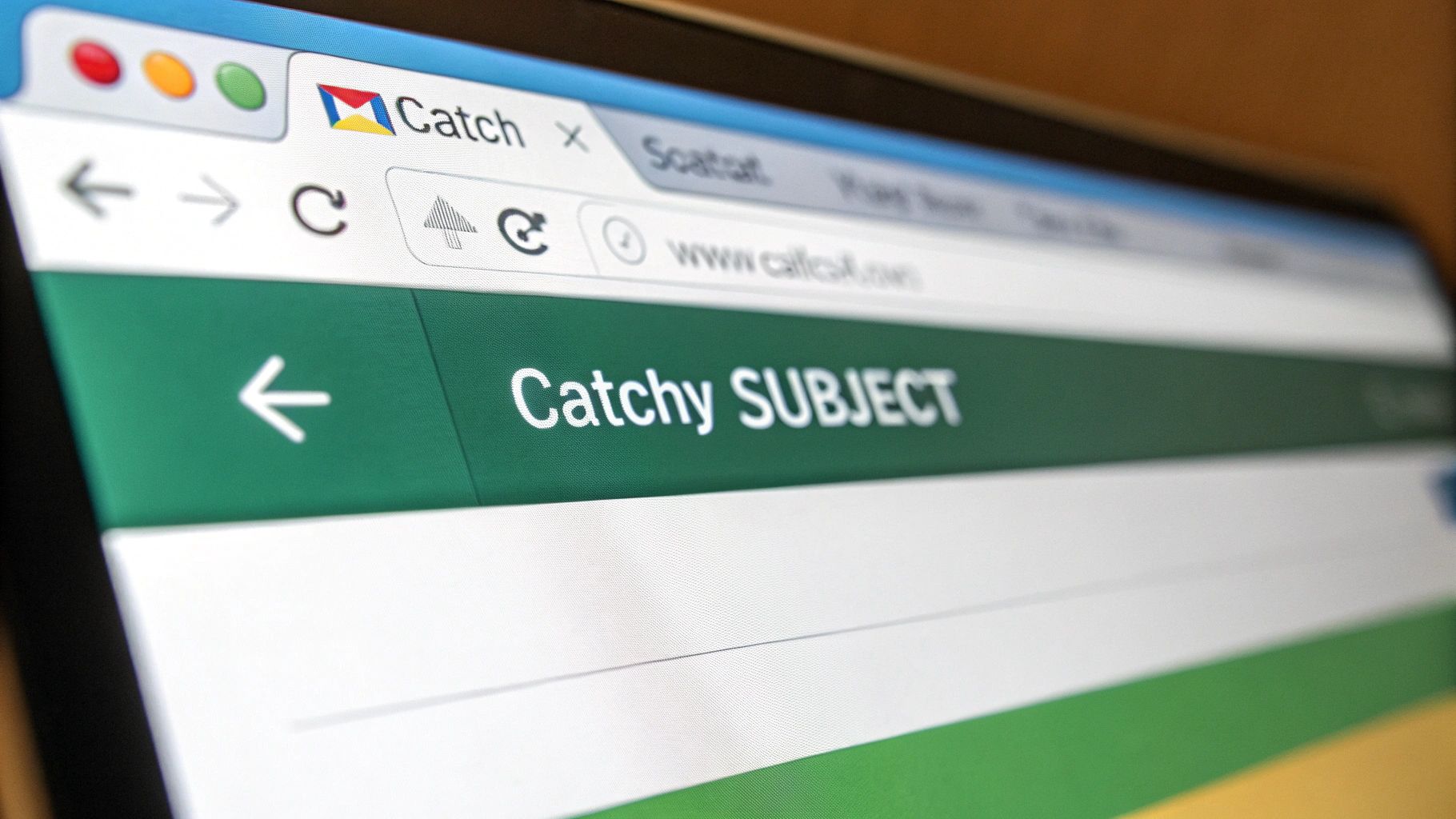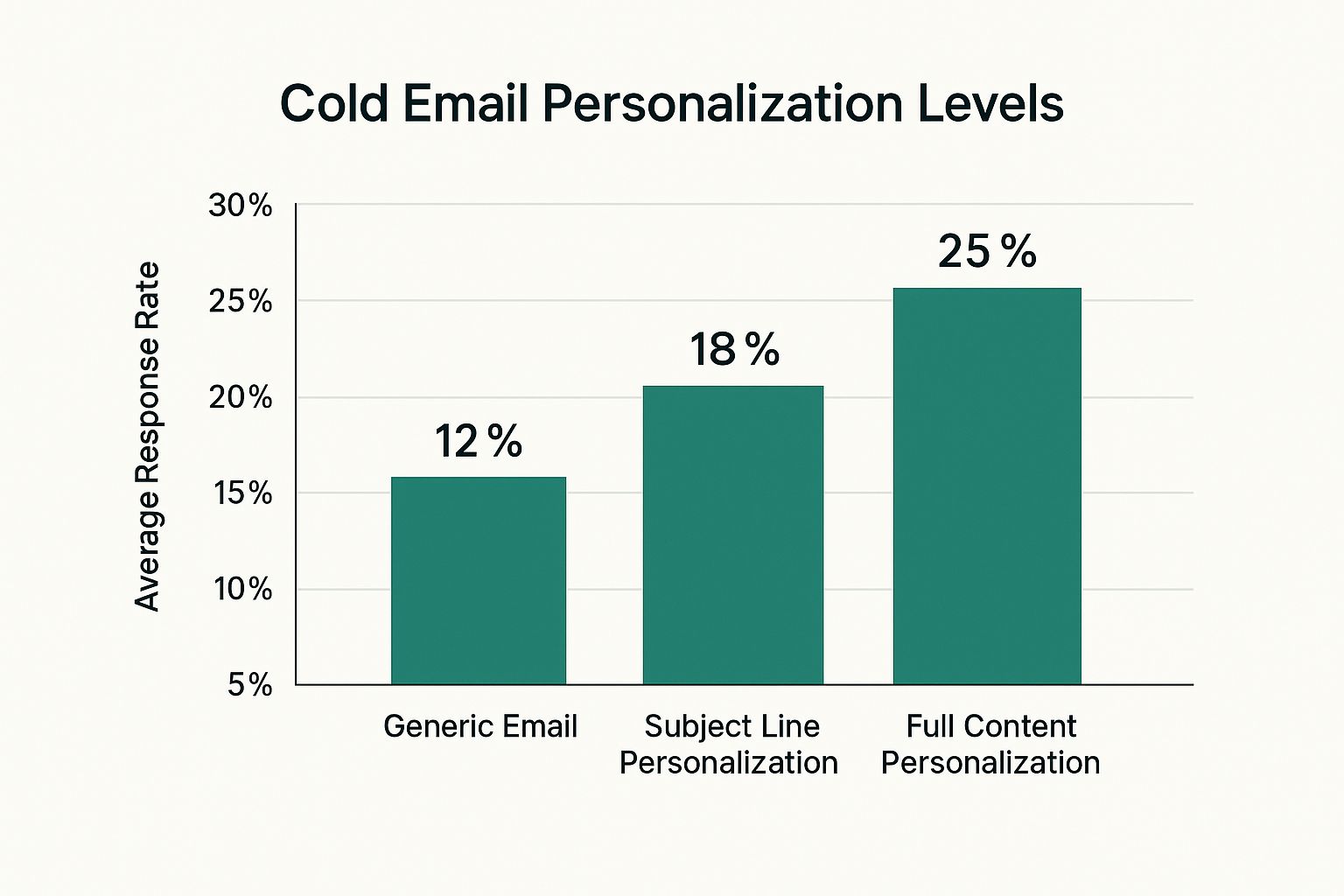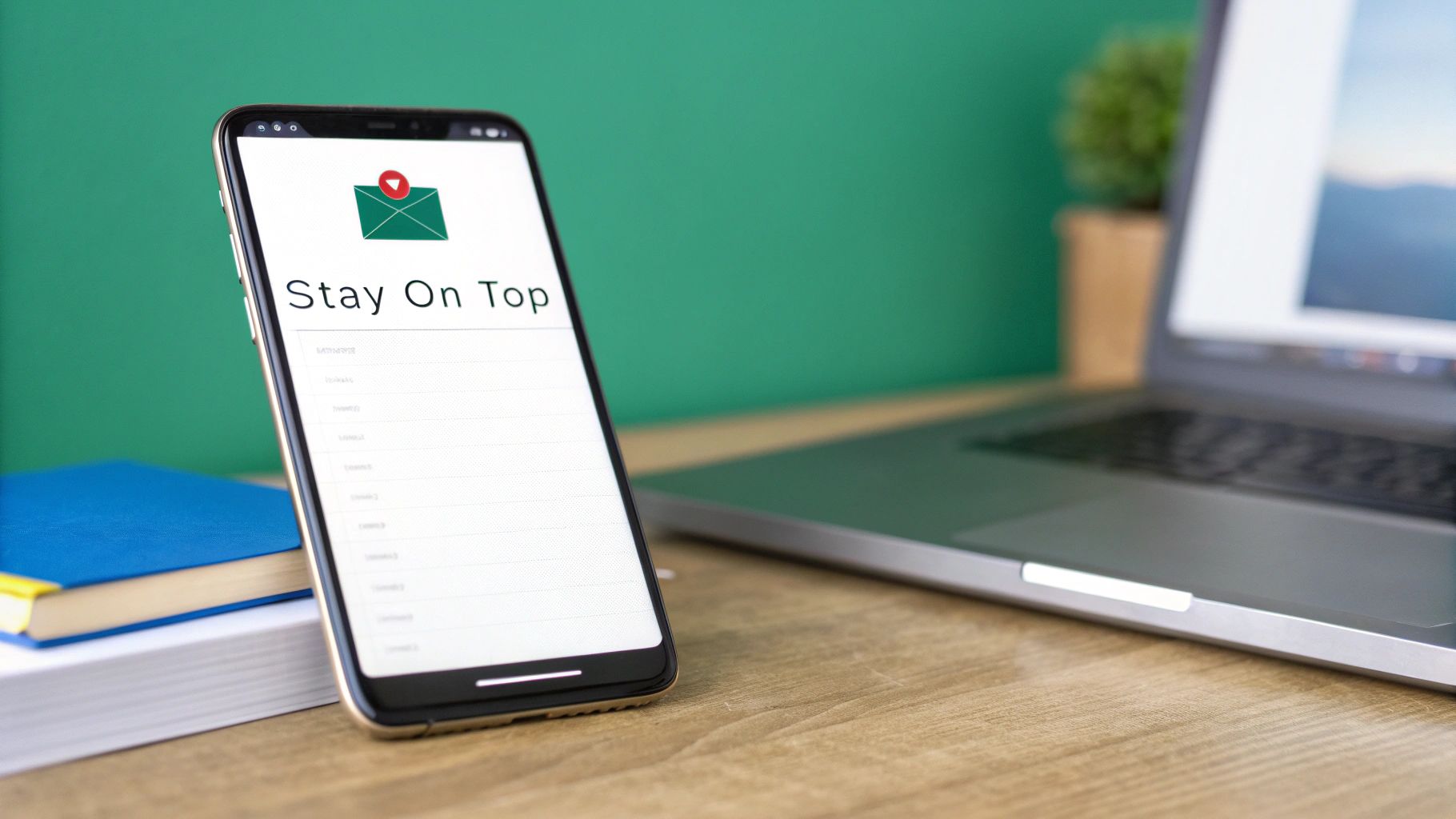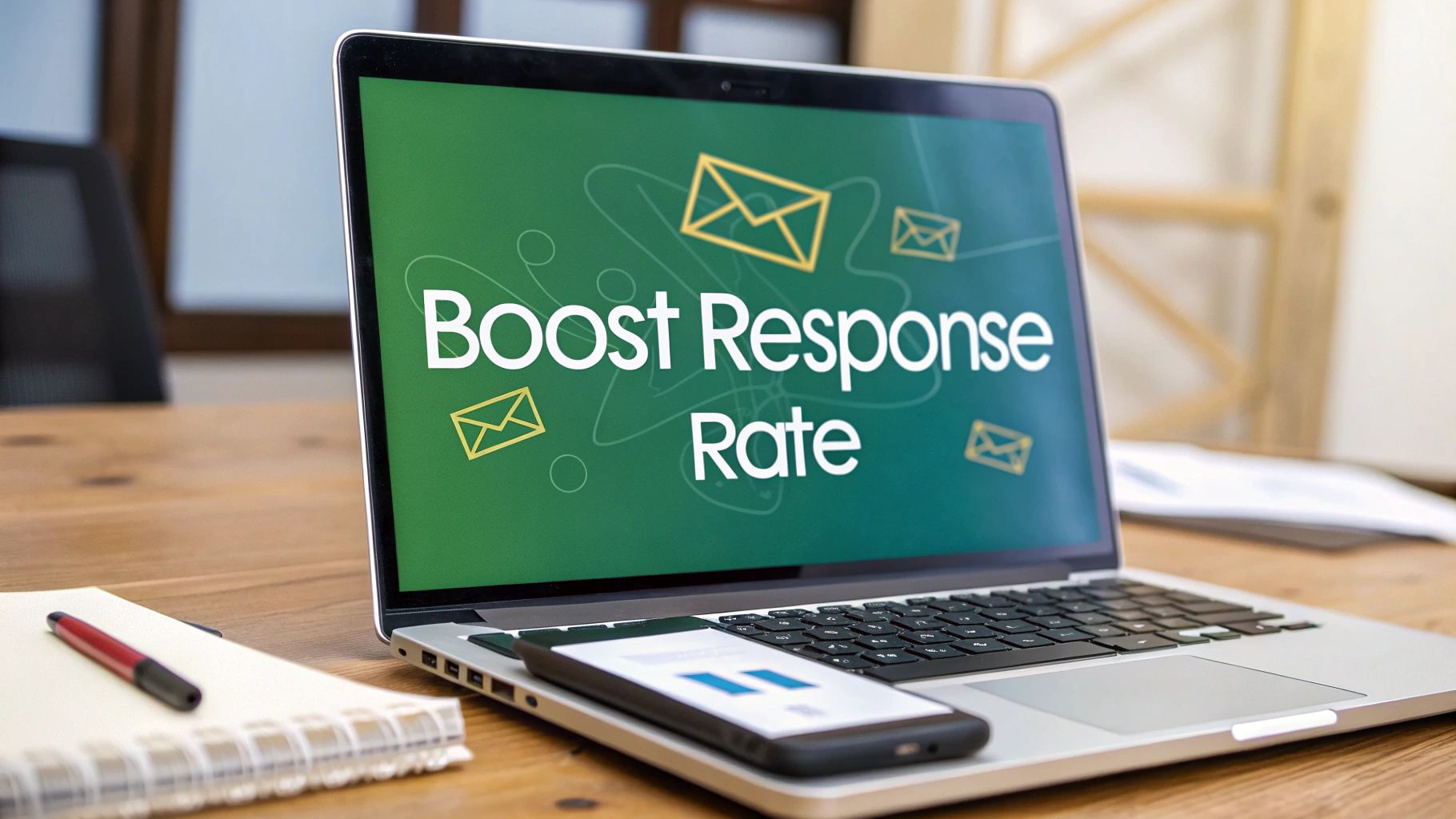So, what’s a “good” cold email response rate?
Honestly, it’s not as simple as picking one magic number. A solid benchmark to aim for is anything over 10%, with most campaigns landing somewhere around the 5% mark.
Think of it like this: if you’re just starting out, even a 1% response rate is a foothold. It’s data. It tells you something is happening, but your targeting or messaging probably needs a serious tune-up. On the flip side, if you're consistently hitting 20% or more, you're in elite territory. That means your personalization, offer, and timing are all working in perfect harmony.
A low rate isn’t a failure—it’s a diagnostic tool. It’s your campaign telling you, "Hey, let's fix this!"
What Do the Numbers Really Mean?
To get a better handle on where you stand, it helps to think in tiers. This gives you a realistic snapshot of your campaign’s health and shows you what to aim for next. Analyzing different email response rates is the fastest way to understand what's working and what isn't.
Here’s a quick reference guide to see how your campaigns stack up against industry standards.
Cold Email Response Rate Benchmarks
| Performance Tier | Response Rate | What This Means |
|---|---|---|
| Needs Work | 1-4% | You're getting started, but something's off. Your targeting might be too wide, or your message just isn't connecting. This is a common starting point with lots of room to grow. |
| Average | 5-9% | You're hitting the industry standard. Your campaign has a decent foundation, but you can definitely boost results by tweaking your subject lines, personalizing more, or strengthening your CTA. |
| Excellent | 10-19% | Now we're talking! Your outreach is sharp and effective. You know your audience, your offer is compelling, and your emails are grabbing attention. |
| Elite Performer | 20%+ | You've cracked the code. Your emails feel like they were written just for the recipient. They're valuable, perfectly timed, and start real conversations. |
Keep in mind, the game is getting tougher.
Recent B2B data shows the average reply rate has dipped to about 5.1%, down from the 7-8% we saw just a few years ago. With around 95% of all cold emails getting completely ignored, a generic, spray-and-pray approach just doesn't cut it anymore.
How to Accurately Measure Your Response Rate

Before you can start improving your numbers, you have to know what they actually are. It's a common trap to use a flawed calculation, which gives you a false sense of either security or failure. You end up trying to fix things that aren't even broken.
The good news? The formula for this is dead simple. There's only one right way to do it.
To figure out your true cold email response rate, you just need three pieces of information: the total number of emails you sent, how many of those bounced back, and the number of unique replies you got.
The Essential Calculation
This is the only formula you should ever use. It’s simple, but every single part is crucial for getting an honest look at your campaign's performance.
(Unique Replies / (Total Emails Sent – Bounced Emails)) * 100 = Your Response Rate
So, why is subtracting those bounced emails so important?
Think of it like sending physical mail. If you send out 100 letters but 20 come back stamped "wrong address," you didn't really try to reach 100 people—you only actually reached 80. The exact same logic applies here.
Your campaign’s success should only be judged by the emails that actually landed in a real inbox. Bounces are a deliverability problem, not a messaging problem. With roughly 17% of emails bouncing on average, ignoring them will seriously skew your results and hide how well your message is really connecting. You can learn more about how bounces impact your metrics at infraforge.ai.
Measuring What Truly Matters
Let’s be honest, just getting a reply isn’t the goal. Getting the right kind of reply is. A high response rate packed with "unsubscribe" or "not interested" messages isn't a win. It's just noise.
This is why you have to segment your replies to understand what’s actually working.
Start tracking different types of responses:
- Positive Replies: These are the gold. Prospects showing interest, asking for more info, or booking a meeting.
- Neutral Replies: This could be someone saying, "I'm not the right person, but try my colleague Jane Doe."
- Negative Replies: These are the straightforward "no thanks" or requests to be removed from your list.
When you separate them out, you get a much clearer picture of your campaign's health. A 5% positive response rate is worlds better than a 10% overall rate that’s mostly rejections.
Why Your Cold Emails Are Getting Ignored

So, you’ve built your list, crafted what you thought was the perfect message, and hit “send.” And now… crickets.
It’s one of the most frustrating feelings in sales and marketing. But here’s the thing: the reason your emails are disappearing into a void almost always comes down to a few fundamental mistakes. You’re not just sending a message; you’re interrupting someone’s day. To get a response, you have to earn it.
Think of their inbox like a crowded, noisy party. A generic, self-serving opener is like shouting into the void—you’ll be ignored. But a thoughtful, relevant comment can start a genuine conversation. If your response rate is in the gutter, your approach is failing that crucial first-impression test.
Most of the time, it boils down to one of these three core issues.
Your Message Is Irrelevant
This is, by far, the biggest killer of cold email campaigns. An irrelevant email isn’t just about offering the wrong product. It’s a message that screams, "I haven't done my homework."
It feels like junk mail because it’s completely disconnected from the recipient's world—their role, their challenges, and their goals.
Research backs this up. A 2024 analysis of over 11 million emails found that while decision-makers actually prefer cold email, a staggering 95.9% of messages go unanswered. The main culprit? A whopping 71% of people cited a lack of relevancy as the number one reason they hit delete. You can read the full research on the state of cold email at hunter.io.
An email only becomes relevant when it solves a problem the recipient is actually thinking about. Pitching social media management to a CFO worried about quarterly financial reporting is a complete waste of everyone’s time.
The Email Feels Impersonal and Automated
Personalization is so much more than just dropping in a {{first_name}} tag. Real personalization shows you’ve invested a moment to understand who you’re actually talking to. It’s the difference between a mass-produced flyer and a handwritten note.
When an email is clearly a generic template blasted to hundreds of people, it triggers an immediate mental spam filter. Prospects can spot these a mile away.
- Generic Compliments: "I love what your company is doing." (Doing what, exactly?)
- Vague Openings: "I came across your profile and was impressed." (Impressive how?)
- No Real Context: The message has zero reference to their recent work, a company announcement, or a shared connection.
This lack of specific detail signals that the sender is just playing a numbers game. It tells the recipient you don't actually care about starting a conversation—you just want to make a sale.
You Haven't Established Any Trust
Let's be honest, you’re a stranger asking for someone's time and attention. In the world of communication, trust is everything. If your email looks unprofessional or even a little sketchy, you’ll never earn it.
Your domain, your email signature, and the clarity of your ask all build your credibility. A message from a generic Gmail account with a fuzzy call-to-action is an immediate red flag. You have to present yourself as a legitimate professional who has a clear, valuable reason for reaching out.
Proven Strategies to Get More Replies
Okay, so you know why your emails might be getting ignored. That’s the first step. Now, let's get into the good stuff—the actionable strategies that turn that silence into actual conversations.
Boosting your cold email response rate isn’t about a single magic bullet. It's about methodically tuning up every single piece of your outreach.
From the second your email hits their inbox to the final call-to-action, every word counts. The goal is to make opening, reading, and replying feel like the most natural thing in the world for your prospect. We'll break down exactly how to do that.
Craft an Irresistible Subject Line
Your subject line has one job and one job only: get the open. Think of it as the bouncer at the club. If it's boring, generic, or looks spammy, your email is getting kicked to the curb (or the archive folder) instantly.
To make your subject line pop, you need to either spark curiosity or show immediate relevance. Forget the clickbait. Just give a tiny hint of the value waiting inside.
- Weak: "Quick Question" (Vague, overused, and immediately forgettable.)
- Strong: "Question about [Recipient's Company] podcast" (Specific, relevant, and shows you've done some homework.)
- Weak: "Introduction from [Your Name]" (No one cares. It's all about them, not you.)
- Strong: "[Mutual Connection] suggested I reach out" (Boom. Instant trust and social proof.)
A great subject line feels personal and professional all at once. It tells the reader that giving you a few seconds of their time won't be a waste.
Personalize Beyond the First Name
Look, true personalization is so much more than just dropping a {{first_name}} tag in your template. It's about proving you have a legitimate, specific reason for contacting them—and not the other 100 people on your list. This is easily the most powerful lever you can pull to jack up your response rate.
Sending a highly personalized message shows you've invested time and respect their position. It instantly changes your email from an annoying interruption into a potential opportunity.
This is where you bring in the "custom snippets"—those specific, recent, and relevant details that make each email feel unique. It proves you're a human, not a robot blasting out emails. The payoff for this effort is huge.

The numbers don't lie. A little bit of genuine personalization can easily double your response rate compared to a generic message.
To make this crystal clear, here’s how different levels of effort play out.
Personalization Levels and Expected Impact
| Personalization Level | Example | Expected Response Rate Impact |
|---|---|---|
| Basic (Low Effort) | Using their first name and company name. | Low. Better than nothing, but barely. |
| Intermediate | Referencing their job title or industry. | Moderate. Shows you're targeting the right role. |
| Advanced (High Effort) | Mentioning a recent LinkedIn post, a quote from a podcast they were on, or a recent company award. | High. This is the gold standard and gets replies. |
Dedicating a few extra minutes to find that advanced, high-effort snippet is almost always worth the return you'll get in replies.
Write a Compelling Email Body
You got the open. Congrats! Now the body of your email has to deliver on the promise your subject line made. This is where you connect their world to your solution. The biggest mistake people make here is talking endlessly about themselves, their company, and their list of features.
Don't do that. Frame the entire message around the recipient.
Start by showing you get it—you understand their world. You can learn a lot more about this in our full guide on how to write cold emails that people actually look forward to reading.
Here's a simple, effective framework:
- The Hook: Kick things off with your personalized snippet. "Saw your LinkedIn post on scaling sales teams…"
- The Problem: Touch on a relevant pain point. "…and it made me think about how tough it is to keep lead quality high during a growth spurt."
- The Value Prop: Gently introduce your solution without a hard sell. "We help B2B tech companies like yours solve this by…"
- The Call-to-Action (CTA): Make the next step incredibly easy and low-friction.
This structure keeps the focus squarely on them and builds a natural bridge from their problem to your solution.
Use a Smart Follow-Up Strategy
Here's a hard truth: most replies don't come from the first email. Not even close.
Campaigns with 4-7 emails in a sequence see a reply rate that is three times higher than campaigns that give up after 1-3 emails. A polite, persistent follow-up strategy isn't optional; it's essential for a healthy response rate.
But "following up" does not mean sending the same email again with "Just checking in" tacked on top. Gross. Each follow-up needs to add a little more value or offer a new angle.
- Follow-Up 1 (2-3 days later): A simple, polite bump. That's it.
- Follow-Up 2 (4-5 days later): Share a relevant case study, blog post, or a surprising stat.
- Follow-Up 3 (1 week later): Reframe your value prop. Try a different angle that might resonate more.
Put these strategies into practice—a killer subject line, deep personalization, a recipient-focused body, and a smart follow-up sequence—and you’ll stop being an annoyance in their inbox and start becoming a powerful conversation starter.
Mastering the Technical Side of Email Deliverability

Here's a hard truth: even the most persuasive, perfectly written email is worthless if it lands in the spam folder. Boosting your cold email response rate isn't just about clever copy. It’s about getting the technical stuff right—the behind-the-scenes setup that trips up most outreach campaigns before they even get a chance to start.
Think of your email domain like a person trying to get through airport security. To get past the gate, they need a passport and an official ID. Technical email settings are your domain’s passport. They prove to email providers like Gmail and Outlook that you are who you say you are.
Without that authentication, your emails look sketchy. They get flagged as suspicious and sent straight to the junk pile. Nailing these fundamentals ensures your messages actually hit the inbox, giving them a fighting chance to get read.
Setting Up Your Domain's Passport
You don’t need to be a developer to get this right. There are three key records that work together to build trust with mail servers and protect your reputation as a sender.
- SPF (Sender Policy Framework): This is like a public list of authorized senders for your domain. It tells the world, "Only these specific mail servers are allowed to send emails on my behalf."
- DKIM (DomainKeys Identified Mail): Think of this as a tamper-proof seal on a physical letter. DKIM adds a unique digital signature to every email, proving that the message wasn't faked or altered on its way to the recipient.
- DMARC (Domain-based Message Authentication, Reporting & Conformance): This is the security guard that checks both the sender list (SPF) and the seal (DKIM). DMARC gives instructions to receiving servers on what to do if an email fails these checks, which protects your domain from being used by spammers.
Setting these up is a one-time task, but it makes a massive difference in your deliverability.
Building Your Sender Reputation
Just like a person has to build up their credit score over time, a new email account needs to establish its sender reputation. You can’t just fire up a brand-new email and blast out 500 messages on day one. That’s exactly what spammers do, and it’s a surefire way to get your account flagged immediately.
The process of gradually increasing your sending volume is called "warming up." It shows ISPs that you're a legitimate user, not a spam bot, by mimicking human behavior over time.
This means starting with just a handful of emails each day and slowly increasing that number over several weeks. A solid warm-up routine is non-negotiable if you're serious about your emails actually landing in front of people.
On top of that, keeping a clean email list is critical for your reputation. You need to get in the habit of using a tool to validate an email address before you hit send. This weeds out the bad or risky contacts, which keeps your bounce rate low and signals to email providers that you're a responsible sender.
Moving Beyond Email with Multi-Channel Outreach
A killer cold email strategy is a fantastic engine for growth, but it works even better when it’s not flying solo. If you really want to crank up your cold email response rate, you have to start thinking beyond the inbox and embrace a multi-channel game plan.
This just means blending your emails with smart, timely touchpoints on other platforms—and for most of us, that means LinkedIn.
Think about it like this: if you meet someone once at a big conference, they’ll probably forget you by the time they get home. But if you run into them a few times over the course of the event, a bit of familiarity starts to set in. You’re not a stranger anymore.
The same principle applies here. By engaging with a prospect’s content or connecting with them on LinkedIn before your first email even hits their inbox, you stop being a random name. This one move can turn a cold outreach into a much warmer one, seriously boosting the odds they’ll actually open and reply to your message.
A Simple Multi-Channel Sequence That Works
Getting this all set up doesn't have to be some complex, over-engineered process. The real goal is just to create a series of light, professional interactions that build recognition without coming across as pushy or desperate.
Here’s a proven sequence you can steal and adapt right away:
-
Day 1: The LinkedIn Touchpoint. Kick things off by simply viewing their LinkedIn profile. After that, find a recent post they shared and leave a genuine, thoughtful comment or give it a like. This is your first, no-pressure signal that you exist.
-
Day 3: The First Email. Two days later, it’s time to send your highly personalized cold email. Now, when they see your name, there’s a flicker of recognition, making your subject line infinitely more compelling.
-
Day 5: The Connection Request. Finally, send a LinkedIn connection request. Keep the note short and sweet: "Really enjoyed your recent post on [Topic]. Thought it would be great to connect."
This approach flips the script, turning your outreach from a single shot in the dark into a well-timed, thoughtful campaign.
A multi-channel strategy is built on a simple truth: your prospects don't just live in their inbox. By meeting them where they are, you build the kind of rapport and trust that every real business relationship is founded on.
This layered approach does more than just boost your immediate response rate. It helps you build a stronger, more engaged network for the long haul. You’ll find yourself shifting from a mindset of just "sending emails" to one of genuinely starting conversations.
Common Questions About Cold Emailing
When you're fine-tuning your cold email game, a few questions always seem to pop up. Getting them answered is the key to breaking through the roadblocks that keep your campaigns from really taking off.
How Long Should I Wait Between Follow-Ups?
This is the big one, and the answer is all about finding that sweet spot. Timing is everything. If you follow up too quickly, you come across as pushy and aggressive. But if you wait too long, you lose all the momentum you built.
The best approach is to create slightly irregular intervals—it just feels more human. A good rule of thumb is to wait 2-3 days after your first email. After that, start stretching it out. Send the next one 4-5 days later, and then maybe wait a full week for the one after that. This keeps you on their radar without clogging up their inbox.
The goal of a follow-up isn't to demand a reply. It's a gentle, professional reminder that adds a bit more value with each touchpoint, showing persistence without being a pest.
The real key here is sticking with it. The data doesn't lie: campaigns that include 4-7 emails in a sequence can see triple the reply rate compared to campaigns that give up after just one or two messages. Don't quit too early, because most of your best replies are hiding in those later follow-ups.
Ready to find the right contacts and build your outreach lists in seconds? EmailScout is a powerful email finder that helps you connect with decision-makers effortlessly. Find unlimited emails for free and streamline your sales outreach. Learn more at emailscout.io.
